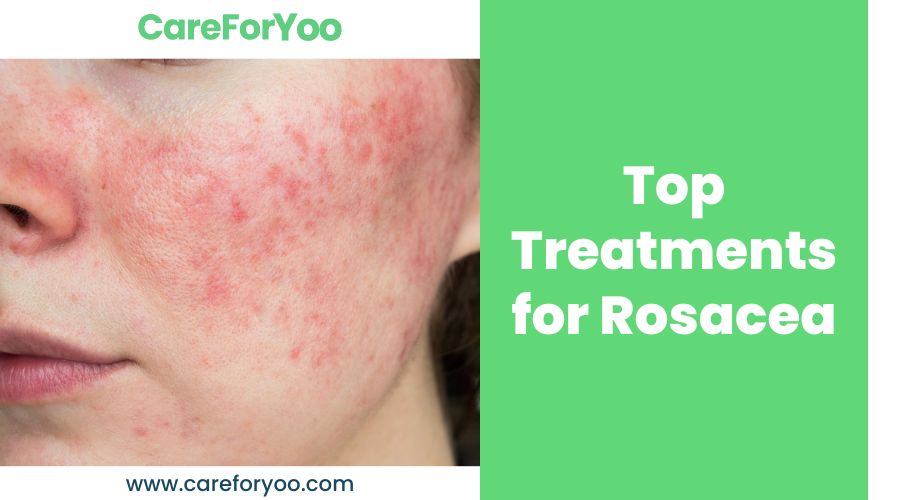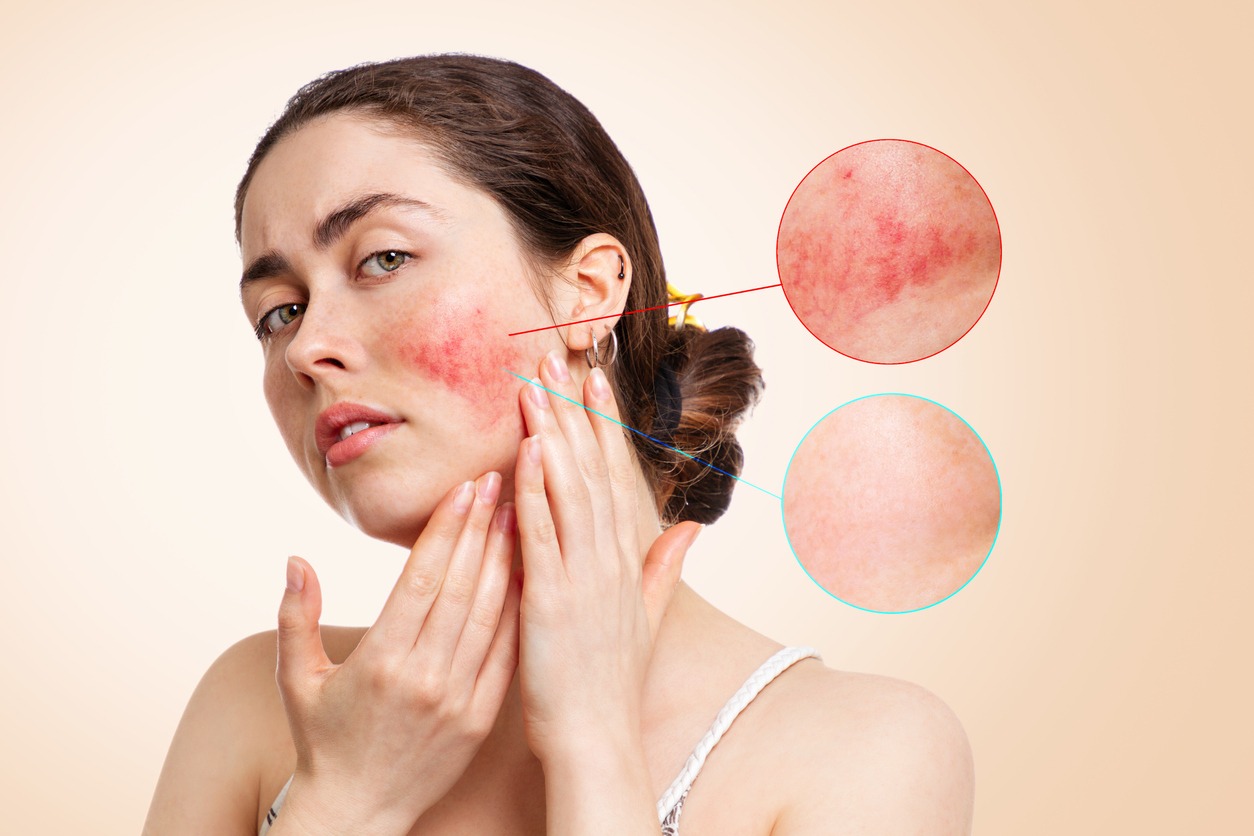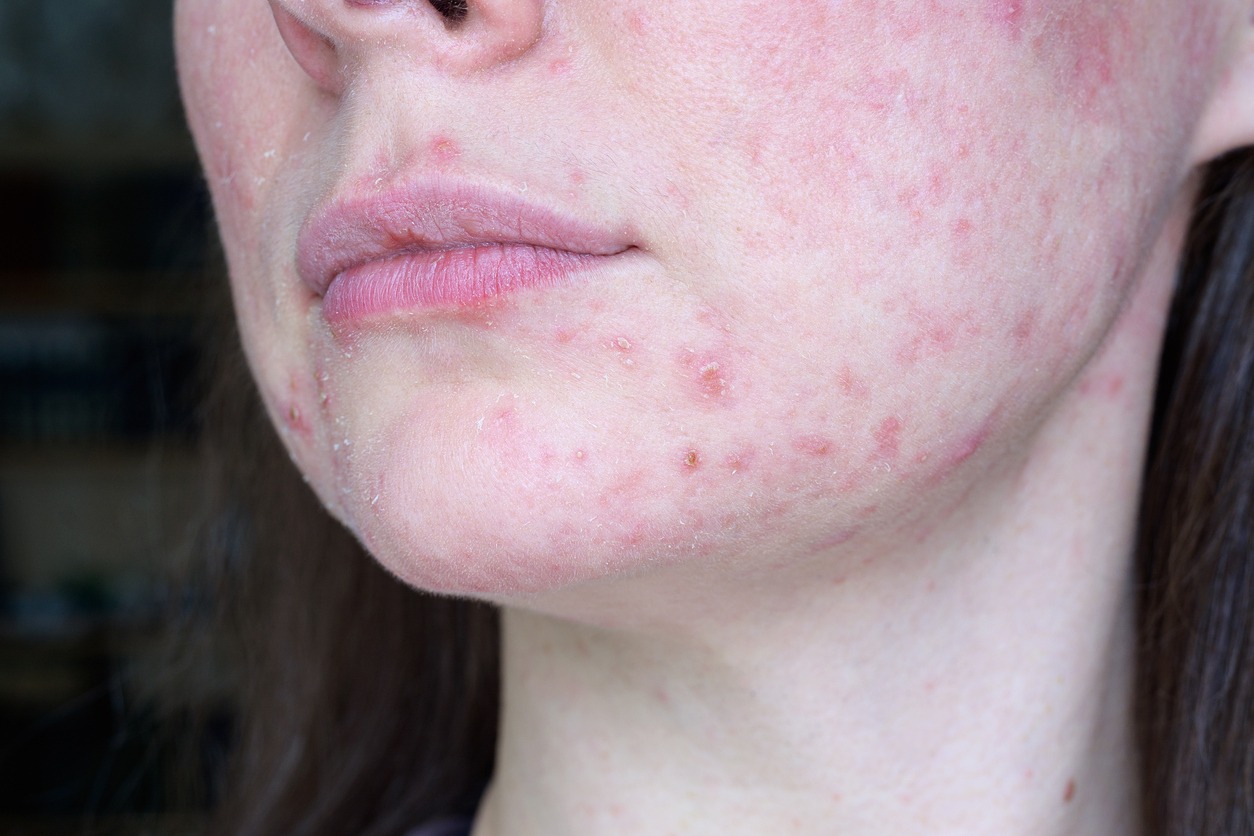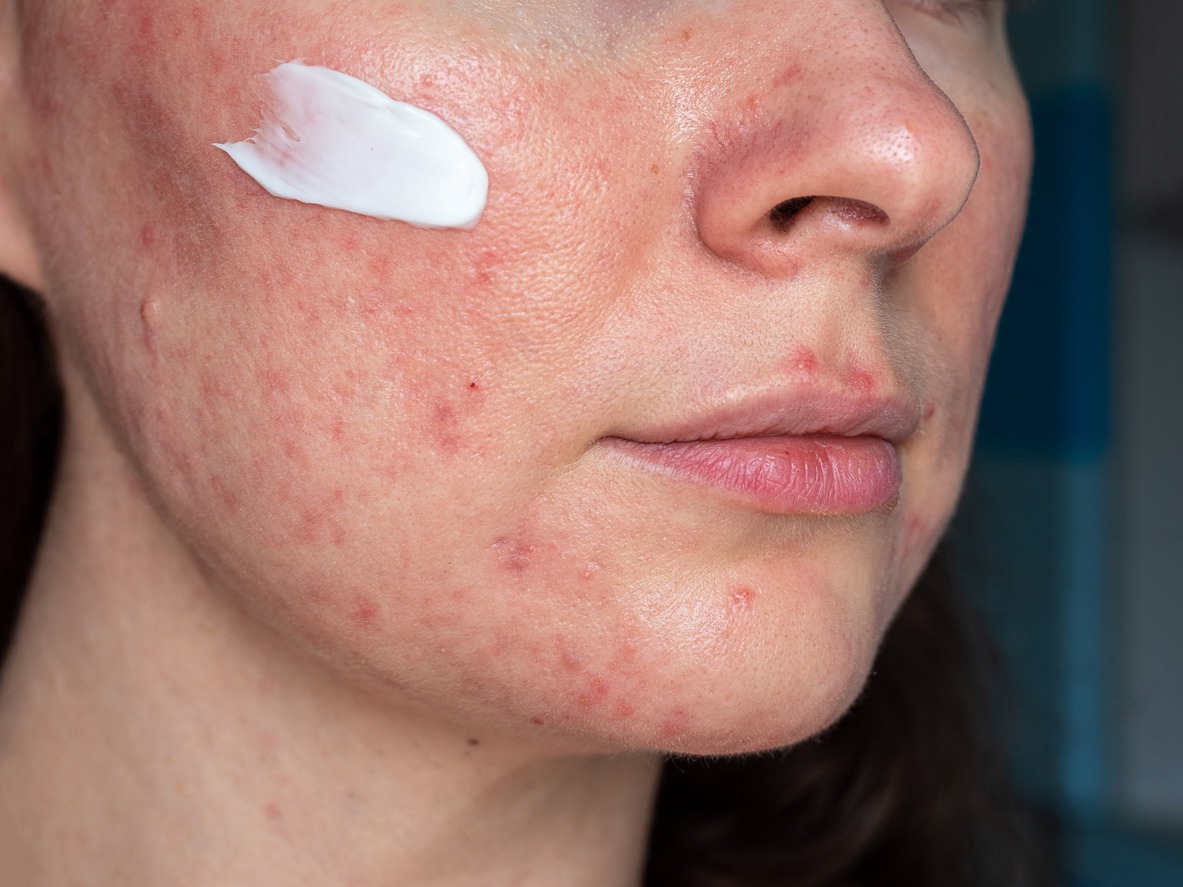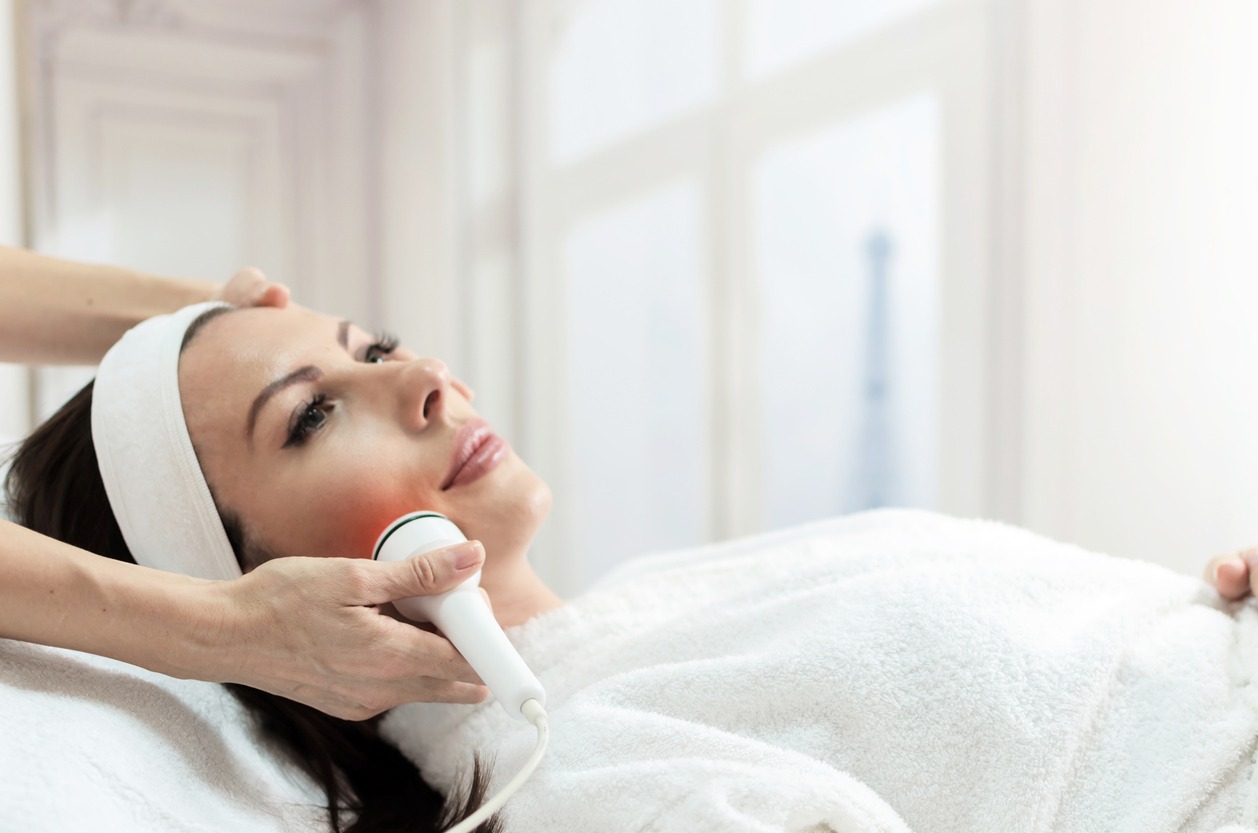Disclaimer: This article is for informational and educational purposes only and does not substitute professional medical advice. It is important to always consult a medical professional for any health issues.
Rosacea is among the skin disorders that are difficult to hide as it causes constant facial redness, bumps that look like acne, or the appearance of broken blood vessels in the skin. It is a chronic skin condition that affects approximately 16 million Americans. There is still no recognized cure for rosacea, nor is there a cause for it. But no worries because through research, doctors were able to find ways how to treat the condition and minimize its symptoms.
This skin condition has four subtypes, and each of them has its own set of symptoms. It is also possible to have more than one subtype of rosacea at a time. The flare-ups also usually occur in cycles. This means that you may experience symptoms for weeks or months at a time. They may go away and then return.[1]
If you’ve been experiencing rosacea and are looking for ways how to alleviate the symptoms, you’re in the right place. In this post, we are giving you the top treatments for rosacea.
Types of Rosacea
As mentioned earlier, there are four types of rosacea. It is essential to learn about these first in order to know the right treatments that you need to alleviate its symptoms. Below are the different types of rosacea:[1]
Subtype One – Erythematotelangiectatic Rosacea (ETR): This kind type of rosacea is characterized by facial flushing, redness, and clearly visible blood vessels.
Subtype Two – Papulopustural Rosacea (Acne Rosacea): This type of rosacea is associated with acne-like breakouts. It is often experienced by middle-aged women.
Subtype Three – Rhinophyma: This is a rare form of rosacea associated with the thickening of the skin on the nose. It mostly affects men and is usually accompanied by another subtype of rosacea.
Subtype Four – Ocular Rosacea: The symptoms of this type of rosacea are centered on the eye area.
Symptoms of Rosacea
The symptoms of rosacea are different between each subtype. Below are the different symptoms that you may experience, depending on the type of rosacea that you have:
Rosacea ETR
If you have this type of rosacea, you may experience flushing and redness in the center of your face. There may also be some visibly broken blood vessels, swollen skin, sensitive skin, as well as stinging and burning skin.[1]
Acne Rosacea
If you have acne rosacea, you may experience acne-like breakouts and very red skin. This may also include oily skin, sensitive skin, broken blood vessels that are visible, and raised patches of skin.[1]
Thickening Skin
If you have rhinophyma, you will notice bumpy skin texture and thick skin on your nose. Aside from that, it may also include thick skin on the chin, cheeks, ears, and forehead. Some may also have large pores and visibly broken blood vessels.[1]
Ocular Rosacea
Ocular rosacea can cause symptoms such as bloodshot, watery eyes, gritty eyes, dry, itchy eyes, and a burning or stinging sensation in the eyes. Aside from those, the eyes may also become sensitive to light, and there may be some cysts on the eyes. Others experience diminished vision and notice broken blood vessels on the eyelids.[1]
What Can Make Rosacea Symptoms Worse?
Although the exact cause of rosacea is unknown, it could be a result of both inherited and environmental causes. Aside from that, it is also known that some things can make the symptoms of rosacea worse. Below are some of them:[1]
- Spicy foods
- Cinnamon, chocolate, tomatoes, citrus
- Hot coffee or tea
- Sunlight
- Wind
- Pollution
- Alcoholic drinks
- Exercise
- Cheese and dairy
- Medications
- Physical and emotional stress
- Having the intestinal bacteria Helicobacter pylori
- A skin mite referred to as Demodex and the bacterium Bacillus oleronius that it carries
- Presence of cathelicidin, a protein that protects the skin from infection
There are also factors that can make you more prone to develop rosacea. The condition mostly occurs between the ages of 30 and 50. It is also more common in people who are fair-skinned, has blond hair, and have blue eyes.[1]
There are also genetic links to rosacea. For instance, you are more likely to develop the condition if you have a family history of it or if you have Celtic or Scandinavian ancestors. Also, women are more likely to develop the skin condition compared to men. But men who develop the condition usually have more severe symptoms.[1]
Treatments for Rosacea
The treatments for rosacea focus on controlling its signs and symptoms. Most of the time, these require a combination of good skincare and prescription medications. The duration of the treatment also depends on the type and severity of the signs and symptoms. Also, for this skin condition, recurrence is common. Below are the different treatment options for rosacea:
Medications
In recent years, there have been new rosacea medications that have been developed. But the type of medication your doctor prescribes depends on the signs and symptoms that you are experiencing. There may be some conditions that require trying different options or a combination of medications to find a treatment that will work best. Below are some examples of prescription medications for rosacea:
- Topical drugs that reduce flushing: Doctors may prescribe a cream or gel that is applied to the affected skin topically for mild to moderate cases of rosacea. Topical creams like Brimonidine and oxymetazoline can help reduce flushing by constricting blood vessels. However, the effect of these medications is temporary. This means that you need to apply them regularly to maintain improvements. Aside from these, there are other topical products that you can use to control mild rosacea, such as metronidazole and ivermectin.[2]
- Oral Antibiotics: Doctors may also prescribe oral antibiotics like doxycycline for moderate to severe rosacea that involve bumps and pimples.
- Oral Acne Medication: If your rosacea is severe and does not respond to therapies, doctors may suggest the use of isotretinoin. It is a strong oral acne drug that helps clean up acne-like lesions of rosacea. However, this medication can’t be used during pregnancy as it can cause serious birth defects.[2]
To provide you more ideas, below are the FDA-approved five ingredients for the treatments of rosacea that you might encounter in the topical drugs and oral medications that doctors will prescribe you with:
- Metronidazole 0.75% and 1%: This is an antibiotic that may be prescribed in combination with another medication. This may come in the form of cream, gel, or lotion, and it can help reduce discoloration, inflammation, and oxidative stress.
- Azelaic Acid 15%: Azelaic acid is a common treatment for papulopustular rosacea. This treatment works by inhibiting the production of reactive oxygen species in immune cells.
- Brimonidine 0.33%: Brimonidine works by constricting blood vessels on the surface of the skin, which helps with persistent rosacea.
- Ivermectin 1%: Ivermectin is an effective treatment for papulopustular rosacea. It treats the skin condition by easing inflammation, fighting microbes, and targeting the Demodex mites in the skin. It can also reduce the appearance of blemishes and bumps associated with rosacea.
- Sulfacetamide 10% with sulfur 5%: Sulfacetamide with sulfur have been effective rosacea treatments in the past, but now they are second-line treatments because of the newer agents available in the market that are safer for the skin.
Keep in mind that your doctor or dermatologist knows the best treatment option for you as they diagnose and check your condition. Do not self-medicate. These treatments are not available over the counter. But if you can’t make it to a dermatologist in person, virtual appointments are also reliable, and some dermatologists are currently offering them.
Laser Therapy
Due to the laser’s focus on visible veining, laser therapy can reduce the visibility of swollen blood vessels. It is effective on skin that is not tanned, brown, or black. However, before you undergo this type of therapy, you need to speak with your doctor first about its risks and benefits.[2]
Keep in mind that laser therapy for rosacea may have side effects. Some of these include swelling and bruising that might last for a few days. During the recovery period, icing and gentle skin care are needed. When laser therapy is done on brown or black skin, it might cause long-term or permanent discoloration of the treated skin.
When you undergo laser therapy, its full effect might not be noticeable for weeks. Also, repeat treatments might be needed periodically to maintain the improved appearance o the skin. This method is also usually considered a cosmetic procedure, which most insurance does not cover.[2]
Lifestyle and Home Remedies
Aside from medications and therapy, there are also self-care practices that may help control the signs and symptoms of rosacea to prevent its flare-ups. Below are some of them:
Determine the Triggers and Avoid Them
Paying attention to what tends to cause flare-ups is important so that you can avoid them.[2] There are many things that may cause rosacea to flare, and these are referred to as “triggers” by dermatologists. Overheating, exposure to cold air, and consuming spicy meals are some of the frequent rosacea triggers. However, keep in mind that these may or may not cause your rosacea to flare, as people have different triggers. For this reason, it’s crucial to identify and steer clear of the things that make your rosacea flare up.[3]
Always Protect Your Face
It is also essential to apply sunscreen liberally every day before heading outdoors. Using a broad-spectrum sunscreen that can block ultraviolet A and ultraviolet B rays and has an SPF of 30 or higher is better. Before using any cosmetics or after using any topical medications for your face, you can use sunscreen. In addition, you can also take other steps to protect your face, like avoiding the midday sun and wearing a hat. During cold, windy weather, wearing a ski mask or a scarf can also help.[2]
Practice Rosacea Friendly Skin Care
Numerous skincare items might irritate your skin, particularly if you have rosacea. There are also skincare habits that can cause rosacea to flare, including scrubbing the skin clean. To prevent flare-ups, it is better to use mild skin care products. Being gentle with your skin is also a must. If you find it difficult to find mild skin care products, you can also ask your dermatologist for recommendations.[3]
Reduce Visible Flushing with Makeup
Some makeup tools and methods can perhaps lessen the look of skin flushing. However, when using makeup products, make sure that they are mild and gentle on the skin to avoid flare-ups.[2]
Skincare Products for Rosacea
If you are thinking of going the over-the-counter route, there are still some available options for you. Just ensure that you are choosing gentle skincare products that can help reduce the redness of your skin. Also, when buying skincare products, it is very important to read the list of ingredients. Make sure that you avoid anything that contains these ingredients, as they can worsen your rosacea symptoms:
- Fragrance
- Alcohol
- Camphor
- Glycolic acid
- Lactic acid
- Menthol
- Sodium lauryl sulfate
- Urea
Below are some of the skincare products that you can use for rosacea:
Cleansers and Face Washes
People with rosacea must cleanse and moisturize their faces daily. It is to help reduce the appearance of symptoms and keep them from flaring up. However, people with rosacea often don’t wash their skin enough, and that’s understandable if their skin already feels irritated.
To cleanse without further irritating the skin, here are some tips dermatologists recommend:
- Choose a mild, gentle, rosacea-friendly cleanser. Avoid fragranced products to prevent irritation.
- Apply the cleanser gently with your fingers using a circular motion.
- Rinse off the cleanser using lukewarm water. Ensure you thoroughly rinse your skin because if some of the cleansers stay on your skin, it may cause irritation.
- Pat your face gently with a clean towel.
Moisturizers
Moisturizer is necessary whether the rosacea causes your skin to be dry or oily. It will help hydrate your skin and reduce irritation, making your skin feel more comfortable. Applying a rosacea-friendly moisturizer or a barrier repair cream can help improve the results of getting treatment. So, along with your doctor-recommended cream or gel, applying moisturizers with it can lessen dryness, peeling, and roughness.
Creams
Creams are friendlier to skin with rosacea, and use this instead of lotion or gel. Creams act as a moisturizer as well.
Sunscreen
Sunlight can worsen rosacea, and it’s actually the most common cause of a rosacea flare-up. Even those with darker skin tones are susceptible to rosacea flare-ups following time spent in the sun.
To reduce flare-ups, wear sunscreen to protect your sensitive skin. Apply a gentle sunscreen before going outdoors, even on cloudy days. Look for sunscreens with the following:
- Zinc oxide, titanium oxide, or both
- SPF 30 or higher
- Broad-spectrum protection
- Silicone (may be listed as dimethicone or cyclomethycaine)
- No fragrance or fragrance-free (but if it says “unscented,” choose another because it still contains fragrance)
Conclusion
Rosacea is a chronic skin disease, and people who have it need to learn how to manage it. It can be challenging to cope with a chronic condition, which is why it is essential to reach out to doctors and dermatologists to learn about the right treatments to alleviate its symptoms and prevent its flare-ups. While there is no cure for rosacea, you can control it successfully by making some lifestyle changes and using effective products. We hope this post helped you learn more about the top treatments for rosacea.
References
[1] Johnson, S. (2019, October 1). Rosacea: Types, causes, and remedies. Healthline. Retrieved January 6, 2023, from https://www.healthline.com/health/skin/rosacea
[2] Mayo Clinic, E. (2021, September 22). Rosacea. Mayo Clinic. Retrieved January 6, 2023, from https://www.mayoclinic.org/diseases-conditions/rosacea/diagnosis-treatment/drc-20353820
[3] American Academy of Dermatology Association, E. (2022). Rosacea: Diagnosis and treatment. American Academy of Dermatology. Retrieved January 6, 2023, from https://www.aad.org/public/diseases/rosacea/treatment/diagnosis-treat

